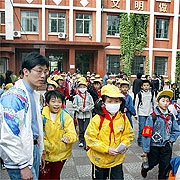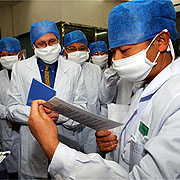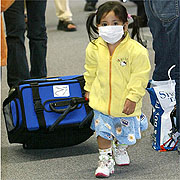By Steve Sternberg, USA TODAY
(Clearwisdom.net) China has fired two Communist Party leaders, closed schools in Beijing and lowered its Great Wall of Silence. Hong Kong's medical system is verging on collapse. Health officials this week have warned people to avoid China, Hong Kong, Singapore, Vietnam and Toronto -- all as a result of SARS.
|
|
A teacher watches as primary school students walk out of the school gate after classes were suspended in Beijing Wednesday. |
||
|
By Goh Chai Hin, AFP |
Only 39 probable cases have been diagnosed in the USA, all but two of them in travelers returning from Asia. But U.S. health officials have adopted stringent precautions to prevent an epidemic of severe acute respiratory syndrome here.
| The rise of SARS | |||||||||||||||||||||||||||||||||||
|
|||||||||||||||||||||||||||||||||||
Will their efforts work?
The most optimistic U.S. experts say that the early action by public health authorities might contain the virus before it becomes lethal here. But others warn that if SARS is not contained, it could cause millions of deaths worldwide -- and some of those deaths would almost certainly occur in the USA.
Because SARS is caused by a newly discovered virus, no one can predict with certainty just how bad it will be. But the epidemic has proven so tough to contain, has traveled so rapidly to so many countries and has inflicted such a major blow to the world economy that health experts are reacting as though SARS is the Big One.
"It would be foolish not to think that this is going to be a serious threat," says Julie Gerberding, director of the federal Centers for Disease Control and Prevention.
In terms of sheer numbers, the SARS epidemic so far pales in comparison to other worldwide epidemics. The Spanish flu of 1918-1919 killed roughly 30 million people, including about 675,000 Americans. Over the past 20 years, the slow-motion funeral march of AIDS has carried off 20 million people; 40 million more are poised to die in the next decade.
Yet SARS is just beginning. The death toll could rise dramatically, especially if the disease expands more in the developing world, where medical care is scarce. And, while Spanish flu traveled via steamship, SARS is jet-propelled and moving so quickly -- especially in China -- that some experts believe it might prove impossible to contain.
Has it already reached that tipping point? It is too soon to say, asserts Anthony Fauci, director of the National Institute of Allergy and Infectious Diseases. But Fauci notes that, in its extreme virulence, SARS can outdo ordinary flu, which kills about 36,000 each year in the USA and an unknown number abroad.
"How many families do you know in the world in which someone gets the flu, comes home, dies from it and then has two family members die from it?" Fauci asks. "How many times have you seen someone come into hospital with influenza, infect 20 health workers and kill two or three of them?"
SARS has done exactly that, killing several members of some families and proving itself particularly deadly to doctors and nurses who care for those who are ill.
No cure, no reliable test
The disease is caused by a newly discovered coronavirus, a member of a large virus family that is notorious among experts for causing about 30% of colds. The SARS virus causes a type of pneumonia that inflames the lungs. There is still no cure or widely available test for SARS, though experimental tests are in the works.
In its most severe form, SARS sends about 15% of patients into intensive care, where they are put on respirators because they can't breathe. About 150 of 450 intensive care beds in Hong Kong are filled with SARS patients, displacing other patients needing intensive care.
Hong Kong health officials warn of a health-system collapse if the epidemic doesn't subside because they'll run short of respirators, as well as room to isolate sick SARS patients and health workers.
Like the flu and AIDS viruses, the SARS virus is believed to have leapt from animals to man, though the new coronavirus bears little resemblance to relatives that infect animals. Some germs that make the species-to-species leap don't adapt to humans well enough to spread from person to person.
But SARS can be exceptionally transmissible in humans. The first known patient in Hanoi, Johnny Chen, 48, infected at least 26 of the health workers who cared for him before he died.
Elizabeth Fee of the National Library of Medicine says SARS -- though still far more limited than flu -- conjures up disturbing echoes of the 1918 epidemic. While writing an article on that epidemic, Fee says, "I found a picture of an army camp where soldiers had been watching a movie. You look out at this sea of soldiers and they were all wearing masks.
"Masks were compulsory for the military," she says. "There were great debates at the time whether masks should be made mandatory for civilians. At the time, I thought it was rather amusing. It's not amusing at all anymore."
Although health officials have estimated that about 5% of those infected with the SARS virus will die, no one knows the exact death rate because they can't yet test all the people with SARS-like symptoms to find out exactly how many are infected.
Nils Daulaire, president of the Global Health Council, says SARS could dwarf flu if it keeps spreading. Even if the death rate were one in 50, he says, rather than one in 20 as it is now, a SARS epidemic that affects half the world's population could kill 60 million people.
"What I hope," Daulaire says, "is that the very aggressive approach taken by international health authorities will contain the epidemic, wherever it is starting to emerge, by locking it in a room so it will burn itself out without threatening larger populations."
That's why the World Health Organization took the unprecedented step on March 12 of issuing a global alert. Three days later, alarmed by cases in Canada, the CDC sounded its own alarm, warning state health officials, doctors and hospitals about the frightening pneumonia-like illness. Anyone hospitalized with SARS is placed in isolation; anyone with suspected SARS is asked to stay home for 10 days to reduce the likelihood that they will infect others.
Record progress
Since the global alert, researchers worldwide have made record progress: They've mapped the geographic distribution of the disease, identified the cause, figured out how it's transmitted, issued recommendations for preventing further spread, isolated the virus and learned how to grow it, reproduced SARS in monkeys, sequenced the virus' genome and produced two experimental tests that, so far, appear to be accurate.
|
By Eugene Hoshiko, AP Members of the World Health Organization (WHO) team are briefed at Changhai Hospital Wednesday. |
"An awful lot has happened quickly," says James Hughes, director of CDC's National Center for Infectious Diseases. "It's stunning."
Despite the rapid pace of scientific progress, public health experts are paradoxically forced to fight a 21st-century pandemic with tools developed hundreds of years ago.
Quarantine dates to 1423, when Venice began confining sailors aboard ships at anchor for 40 days to safeguard the city from plague. Quarantine derives from the Latin word quaresma, for 40.
Another tactic now critical to the SARS-control effort -- handing out printed health alerts to airline passengers arriving from Singapore, Vietnam, Hong Kong, China and Toronto -- stems from the 19th-century fight against cholera. Britain, a maritime nation dependent on global trade, found quarantine disruptive to trade and developed an alternative, says historian Randall Packard of Johns Hopkins University. Rather than quarantining ships, British authorities notified ships' crews that they might be carrying illness and began identifying and monitoring people who appeared to be ill.
A modern version of the British approach is underway worldwide. Since the global alert, health workers in airports and sea ports have distributed 500,000 health alerts to passengers arriving from SARS hotspots, advising them that they may have been exposed to the disease and to visit a doctor if they experience symptoms.
The health alert also advises doctors to notify local health officials that they've identified a suspected SARS case. "Anecdotal evidence suggests that the word is getting out," Hughes says. "Some of our suspect cases have shown up for medical care carrying cards they received when they entered the country. Others gave (hospitals) a heads-up, allowing them to quickly take ... precautions.
"These may be old tools," Hughes says, but "I think they're having some impact here."
They'll become less critical once tests are available, he says, because health workers will be able to identify infected people and isolate them to protect the uninfected.
A threat everywhere
As long as SARS continues spreading anywhere, says Daulaire, of the Global Health Council, it remains a threat everywhere. The outbreaks in Hong Kong and Toronto, for instance, were traced to one infected person entering the city and infecting others.
WHO spokesman Dick Thompson puts it this way: "One case brought down Hong Kong. One case brought down Toronto. One case is a big number."
The seeds of the Hong Kong outbreak were sown by Liu Jianlun, 64, a doctor from Zhongshan University in China's Guangdong province. Liu had checked into room 911 at Hong Kong's Metropole Hotel, across the hall from Johnny Chen, the Chinese-American patient evacuated from Hanoi.
Chen apparently didn't infect Liu, who was feeling ill when he arrived. Liu would later warn his doctors and nurses at Hong Kong's Princess Margaret Hospital to isolate him because he had been treating patients in Guangdong.
On Feb. 21, Liu felt well enough to sightsee with his brother-in-law. Liu died March 4, his brother-in-law soon after, and the Princess Margaret outbreak had begun.
On Feb. 21, Kwan Siu-chu, 78, of Toronto was also staying on the ninth floor of the Metropole. After returning to Toronto three days later, she infected five members of her family, including her son. Kwan died March 5, her son on March 13. By March 25, the chain of infection that began with Kwan extended to 14 health workers at Toronto's Scarborough Grace Hospital.
Also staying in the Metropole were two young women from Singapore, one of them a flight attendant who infected 100 others with the SARS virus. One of the earliest cases in southern China, health officials say, infected roughly the same number. WHO investigators refer to him as "the walking biological weapon."
SARS' potential for explosive spread is why WHO has focused so intently on the outbreak in China, where SARS got its start. China's inability to deal with SARS aggressively at the outset -- by failing to report the outbreak for four months -- enabled the disease to slip into Vietnam, Singapore and Hong Kong, and then to go global.
Over the past few days, a cover-up in Beijing cost Mayor Meng Xuenong and Health Minister Zhang Wenkang their jobs. Their lack of an adequate response has cost not just lives in China, but more importantly in the long run the faith of the city's residents.
'Don't know what the truth is'
"We are coming to realize that we don't really know what is going on and the government is not credible," says Xiao Feng, a 20-year-old mathematics student at Beijing University. "We are scared because we don't know what the truth is or how to ever know what the truth is."
|
By Shizuo Kambayashi, AP A girl arrives Wednesday at New Tokyo International Airport after flying in from Hong Kong. |
More than 480 cases have been identified in Beijing, and citywide surveillance is just getting started. Cases have also been reported in Shanghai and in poor, rural western provinces, where the public health system is in collapse, says Henk Bekedam, head of WHO's China team.
That's the bad news. The good news, says Bekedam, is that the government has ordered all 29 Chinese provinces to make SARS a top priority. It has funded a program to train and deploy 2,500 health workers, to bolster efforts to diagnose cases and trace others they may have exposed.
"I think (the government) knows what the challenge is," he says, adding that Chinese officials are very concerned about SARS' impact on trade, tourism, economic development and the isolation imposed by travel restrictions.
More questions to answer
Moreover, researchers worldwide are trying to answer basic questions that may have a major effect on control efforts:
Why are some people apparently super-spreaders capable of infecting large numbers of people?
Why do some people become deathly ill and other people have only mild symptoms?
Do some people, or many people, have silent infections that enable them to unwittingly pass the virus to others?
Can the virus spread through other means than close face-to-face contact? (A team of WHO investigators arrived in Hong Kong on Wednesday to determine whether an unusual outbreak in one wing of a large apartment building in the complex known as Amoy Gardens has spread through the plumbing, after a toilet swab turned up traces of the virus.)
Without some answers, health officials say, they are reluctant to predict what the outcome will be.
"We're still in the early evolutionary stages of this epidemic," says Fauci, of NIAID. "It would be folly to try to predict whether this is going to evolve into a big-time flu-like epidemic, or something less than that. We just have to try to contain it as best we can."
http://www.usatoday.com/news/health/2003-04-23-sars-cover-usat_x.htm
Category: Falun Dafa in the Media








